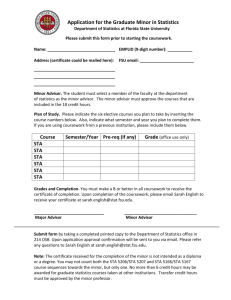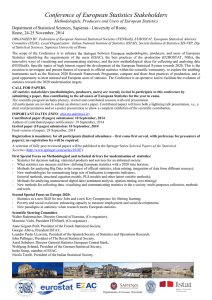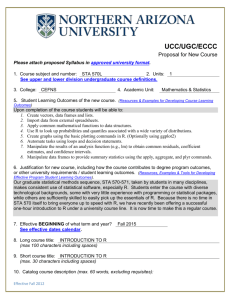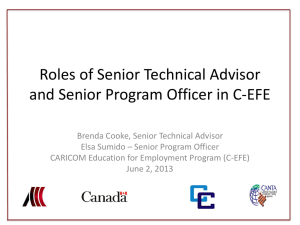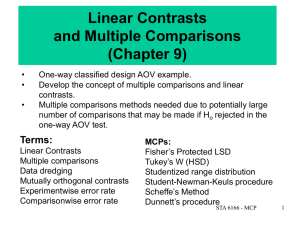STA 291
advertisement
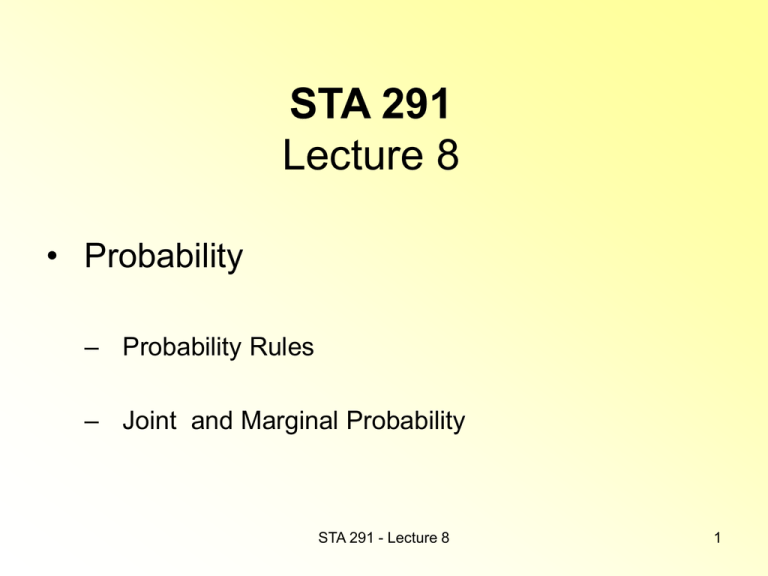
STA 291
Lecture 8
• Probability
– Probability Rules
– Joint and Marginal Probability
STA 291 - Lecture 8
1
Union and Intersection
• Let A and B denote two events.
• The union of two events:
A B
• The intersection of two events:
A B
STA 291 - Lecture 8
2
Complement
• Let A denote an event.
• The complement of an event A:
AC
Law of Complements:
P ( A) 1 P ( A )
c
STA 291 - Lecture 8
3
Additive Law of Probability
Let A and B be two events in a sample space S. The probability
of the union of A and B is
P( A B) P( A) P( B) P( A B).
Let A and B be two events in a sample space S. The probability
of the union of two disjoint (mutually exclusive) events A and
B is
P( A B) P( A) P( B).
STA 291 - Lecture 8
4
Using Additive Law of
Probability
Example: At State U, all first-year students must take
chemistry and math. Suppose 15% fail chemistry, 12% fail
math, and 5% fail both. Suppose a first-year student is selected
at random. What is the probability that student selected failed
at least one of the courses?
What is the probability that
student pass both?
A
B
S
STA 291 - Lecture 8
5
Disjoint Events
• Let A and B denote two events.
• Disjoint (mutually exclusive) events:
A B
• No overlap
STA 291 - Lecture 8
6
Probability tables
• Simple table: One row of outcomes, one
row of corresponding probabilities.
• R x C probability tables: when the
outcomes are classified by two features
STA 291 - Lecture 8
7
• Gender and support President Obama?
• Smoker? And Lung disease?
• Age group and support Obama?
STA 291 - Lecture 8
8
Example: Smoking and Lung Disease
Lung
Disease
No Lung
Disease
Marginal
(smoke status)
Smoker
0.12
0.19
0.31
Nonsmoker
0.03
0.66
0.69
Marginal
(disease status)
0.15
0.85
1.0
STA 291 - Lecture 8
9
Frequency table and
probability table
Lung
Disease
No Lung
Disease
Smoker
120
190
Nonsmoker
30
660
(total) Marginal
(disease status)
(total) Marginal
(smoke status)
1000
STA 291 - Lecture 8
10
• Equivalent to a table with 4 entries:
(smoker & lung disease)
(smoker & not lung disease)
(nonsmoker & lung disease)
(nonsmoker & not lung disease)
0.12
0.19
0.03
0.66
But the R x C table reads much better
STA 291 - Lecture 8
11
• From the R x C table we can get a table
for smoker status alone, or disease
status alone.
• Those are called marginal probabilities
STA 291 - Lecture 8
12
It’s a one way street
• Given the joint probability table, we can
figure out the marginal probability
• Given the marginal, we may not determine
the joint: there can be several different
joint tables that lead to identical marginal.
STA 291 - Lecture 8
13
Example: Smoking and Lung Disease
Lung
Disease
Not Lung
Disease
Marginal
(smoke status)
Smoker
0.02
0.29
0.31
Nonsmoker
0.13
0.56
0.69
Marginal
(disease status)
0.15
0.85
Same marginal, different joint.
STA 291 - Lecture 8
14
Using the table
• P(smoker and lung disease ) = 0.02
• P(smoker
or lung disease ) = 0.44
(either by looking at the table
Or using the additive rule for probability)
STA 291 - Lecture 8
15
Independence of events
• May not always hold.
• If and when it hold: With independence,
one way street becomes two way street.
• Smoking and lung disease are obviously
not independent in reality.
STA 291 - Lecture 8
16
Independence
•
•
If events A and B are independent, then the
events A and B have no influence on each
other.
So, the probability of A is unaffected by
whether B has occurred.
STA 291 - Lecture 8
17
Multiplication rule of probability
If A and B are two independent events, then
P( A B) P( A) P( B).
• i.e. joint prob. = product of two marginal prob.
STA 291 - Lecture 8
18
Conditional Probability
P( A B)
P( A | B)
, provided P( B) 0
P( B)
•
Note: P(A|B) is read as “the probability that A
occurs given that B has occurred.”
STA 291 - Lecture 8
19
Independent Events
Multiplication Rule for Independent Events: Let A and B
be two independent events, then
P( A B) P( A) P( B).
Mathematically, if A is independent of B, then: P(A|B) = P(A)
Examples:
• Flip a coin twice. What is the probability of observing two heads?
• Flip a coin twice. What is the probability of getting a head and then a tail? A
tail and then a head?
STA 291 - Lecture 8
20
• In general, if events A and B are not
independent, then the multiplication rule
becomes
P( A B) P( A) P( B | A)
STA 291 - Lecture 8
21
Terminology
•
•
•
P(A∩B)=P(A and B)
Joint probability of A and B
(of the intersection of A and B)
P(A|B)
Conditional probability of A given B
P(A)
(Marginal) probability of A
STA 291 - Lecture 8
22
• If we have the probability table, then
everything can be figured out from the
table. NO need to use the rules.
• Only when no table is available, then we
may be able to find out some probabilities
from some given/known probabilities (a
partial table) using rules.
STA 291 - Lecture 8
23
• In homework/exam, you may be given a
probability table, and are asked to verify
certain rules.
Or
• Given a partial table, you are asked to use
various rules to find the missing
probabilities in the table.
STA 291 - Lecture 8
24
Examples
STA 291 - Lecture 8
25
Homework
STA 291 - Lecture 8
26
Attendance Survey Question
• On a 4”x6” index card
– Please write down your name and
section number
– Today’s Question:
– Is A independent of B in reality?
A={Stock market go up today};
B={snow > 3 inch in New York today}
STA 291 - Lecture 8
27
